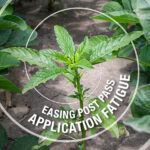Season-Long Best Practices Help Prevent Volunteer Corn
Severe weather and insect pressure may increase the incidence of volunteer corn — strategize before rotating to soybeans.

When it comes to troublesome weeds, most growers rightly think of waterhemp or Palmer amaranth, but volunteer corn is the unexpected villain you don’t want your soybeans to face — and it’s on the rise.
High winds and severe storms across the country, especially in the Midwest, contribute to downed corn. This has likely had a substantial impact on the amount of volunteer corn in the following year’s soybean crop, a complication that can spell trouble for unprepared growers.
Like other weeds, volunteer corn competes for nutrients, water and light. Clumps of volunteer corn can cause soybean yield losses of up to 54%. According to University of Nebraska-Lincoln Extension, volunteer corn can drastically reduce soybean yield even at low densities. At 5,000 volunteers/acre, approximately one volunteer corn plant per every 3.5 feet of row, soybean yields can be reduced by 20%.
It also reduces the value of corn-soybean rotation used for corn rootworm management by providing a food source for corn rootworm larvae that hatch out in the field. If volunteer corn silks, it can attract egg-laying corn rootworm beetles that will wreak havoc on next year’s corn.
Managing volunteer corn is necessary to achieve maximum yield potential this year and in years to come.
Start Early to Prevent Volunteer Corn
Prevention should be your primary strategy and starts well before harvest. Start strategizing before rotating to soybeans.
- Prioritize season-long insect management. Insect damage can increase the incidence of dropped kernels and lodged corn that can germinate next season. Plant insect-resistant hybrids, scout vigilantly and make timely insecticide applications to set your fields up for success.
- Carefully harvest lodged corn. Severe weather means that lodged corn is sometimes unavoidable. If you still see lodged corn at harvest, proceed with caution. Follow best practices to harvest lodged corn to salvage as much yield as possible while preventing lost kernels from emerging next season.
- Consider post-harvest tillage or make a plan for crop residue. If you suspect that weather or insect damage increased your risk for volunteer corn, consider post-harvest tillage. Tillage can reduce seed-to-soil contact and expose kernels to winter freezes. For no-till operations, grazing livestock or baling crop residue can help reduce volunteer corn in fields with significant lodging.
Control Volunteer Corn in Soybeans
Controlling volunteer corn after emergence requires a different strategy.
Delaying planting until volunteer corn emerges can allow for burndown herbicide applications. Non-selective herbicides like Gramoxone® SL 3.0 can help eliminate glyphosate-resistant volunteer corn. For conventional corn, glyphosate is an option. In corn without the Enlist® trait, Fusilade® DX is an option. If in doubt, talk to your your local Syngenta representative.
Volunteer corn becomes more difficult and costly to control after soybeans emerge. Save yourself some heartache (and cash) by applying full rates of herbicides when volunteer corn is one foot tall or less.
The longer volunteer corn persists in your fields, the more it will cost soybean yield potential, even if it dies off by harvest. Act early to preserve yield potential and keep volunteer corn from interfering with harvest.
2 Min Read
- Volunteer corn needs to be treated as a weed because it interferes with harvest, reduces the value of crop rotation and causes yield losses of up to 50%.
- Season-long strategies can help prevent volunteer corn and reduce control costs.
- Growers need to be armed with knowledge about last year’s crop and this year’s herbicide options to control volunteer corn in soybeans.
More Articles About Field Insights
RECOMMENDED FOR YOU
2 Min Read























